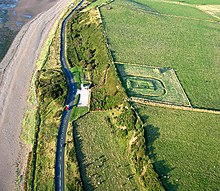User:Musa Chirikeni/test.
| Crosscanonby | |
|---|---|
Location within Cumbria | |
| Population | 1,054 [1] |
| OS grid reference | NY0690139075 |
| • London | 259 miles (417 km) SE |
| Civil parish |
|
| District | |
| Shire county | |
| Region | |
| Country | England |
| Sovereign state | United Kingdom |
| Post town | CROSSCANONBY |
| Postcode district | CA15 |
| Dialling code | 01900 |
| Police | Cumbria |
| Fire | Cumbria |
| Ambulance | North West |
| UK Parliament | |
Crosscanonby is a village and civil parish in the Borough of Allerdale, Cumbria, England. Crosscanonby is 23 miles (37.0 km) Southwest of Carlisle, 8.8 miles (14.2 km) South of Silloth and less than 2 miles (3.2 km) Northeast of Maryport. The parish includes the villages of Birkby, Crosby, Crosby Villa and Crosscanonby. The parish is situated within the Solway Coast,a region designated by the United Kingdom as an Area of Outstanding Natural Beauty,(AONB).
The parish council has 10 members. It is part of the Ellen ward of Allerdale borough, the Dearham and Broughton division of Cumbria county and the Workington Parliamentary Constituency.
The population, approximately (1.054), is served by 1 public house, (The Stag Inn) and 1 Primary School.
The Village[edit]
Crosscanonby is located less than a mile from cumbria's West Coast, 0.5 miles off the A5996 and North of the river Ellen. It is where the Norman church, St John the Evangelist's Church, Crosscanonby is situated, along with the Crosscanonby Carr. North of the village is where the Crosscanonby salt pans are found. Being known fir its history as the location where salt was produced from the 1630s until about 1760,it is thought that some of the worker's cottages were contructed in this village at the same time. These cottages became a pub, then reverted to being cottages again in 1900. The coast road, B5300, which runs through the middle if the salt pans was built in 1824.[2]
Crosscanonby Parish church[edit]
Crosscanonby church, a grade I listed building[3] , St John the Evangelist's Church, Crosscanonby occupies one of the earliest Christiian sites in Cumbria. the church was built in 1130 A.D.[4] and has been extensively restored since 1880. The southwest view includes a Viking era gravestone in the lower centre to the church wall. Some of the stonework in the original construction is believed to have come from earlier Roman settlement in the Crosscanonby area. Outside the church you can see the local salt tax officer John Smith, who died in 1730. The tomb has a unusual panel showing the salt officer working at his desk.[5]

Crosscanonby Carr[edit]
This is a nature reserve, the first in the Solway Plain AONB. It first began as a Solway Plain Rural Initiative Project, which evolved from a vandalised site. Crosscanonby Carr now provides a wetland, meadow and woodland refuge for numerous animals, birds and plants. The site has an Access for All Trail provided for people with all disabilities[6] .
Education[edit]
Crosscanonby has one local Primary School, Crosscanonby St John's CofE School, located in the Village of Crosby. The primary school has approximately 66 students aged 4-11 on role.[7]
History[edit]
Along the coast is Milefortlet 21 and the Salt pans. Milefortlet 21, a designated World Heritage Site, is believed to be dating back to the 79A.D. and 122A.D.[8] , revealing a wealth of information about the lifestyle of Roman troops in Britain. Milefortlet21 was part of a system of defence, including Hadrian's Wall, developed to protect this far flung corner of the Roman Empire.
Close nearby are the remains of the Elizabethan salt pans. it is thought that they were began around 1630 and leased to Richard Barwise in 1634. On the beach was a water tank on a wooden scaffold, whose footings remain, from which sea water ran onto the Sleech in the Kinch. Sleech is the sand from the beach; the Kinch where it was piled up is the large pond, sealed by puddled clay. The remains of these salt pans can be clearly seen to date. the strong brine from the Kinch trickled down to the south. The brine was then boiled in iron pans to produce salt, which crystalised out of the brine.
From 1698 a salt tax was levied. One salt tax Officer was John Smith, (died in 1730), whose tombstone is at St John the Evangelist's Church, Crosscanonby, with a carving of him at his desk.[9]

Transport[edit]
The nearest train stations are Maryport rail station 2.62 miles (4.2 km), and Flimby rail station 4.44 miles (7.1 km).
References[edit]
- ^ "Parish Headcount_people". Office for National statistics.
- ^ "Crosscanonby Village". The Cumbria Directory. Retrieved 2012-02-15.
- ^ "St Johns Evangelist Church, Crosscanonby". Retrieved 03-03-2012.
{{cite web}}: Check date values in:|accessdate=(help) - ^ [file:///F:/crosscannonby%20research/Church%20Of%20St.%20John%20The%20Evangelist,%20Crosscanonby%20%20Flickr%20-%20Photo%20Sharing!.webarchive "History of the church"]. Flickr. Retrieved 01-03-2012.
{{cite web}}: Check|url=value (help); Check date values in:|accessdate=(help) - ^ "St Johns Evangelist Church & John Smith". The Cumbria Directory. Retrieved 15-02-2012.
{{cite web}}: Check date values in:|accessdate=(help) - ^ "Crosscanonby Carr". SolwayCoastAOAB.org. Retrieved 25-02-2012.
{{cite web}}: Check date values in:|accessdate=(help) - ^ "Crosscanonby St Johns CofE school". Schooletc.co.uk. Retrieved 06-03-2012.
{{cite web}}: Check date values in:|accessdate=(help) - ^ "Roman Milefortlet". SolwayCoastAONB.org. Retrieved 18-02-2012.
{{cite web}}: Check date values in:|accessdate=(help) - ^ "The Salt Pans". Department of Geography, Portsmouth. Retrieved 28-02-2012.
{{cite web}}: Check date values in:|accessdate=(help)

